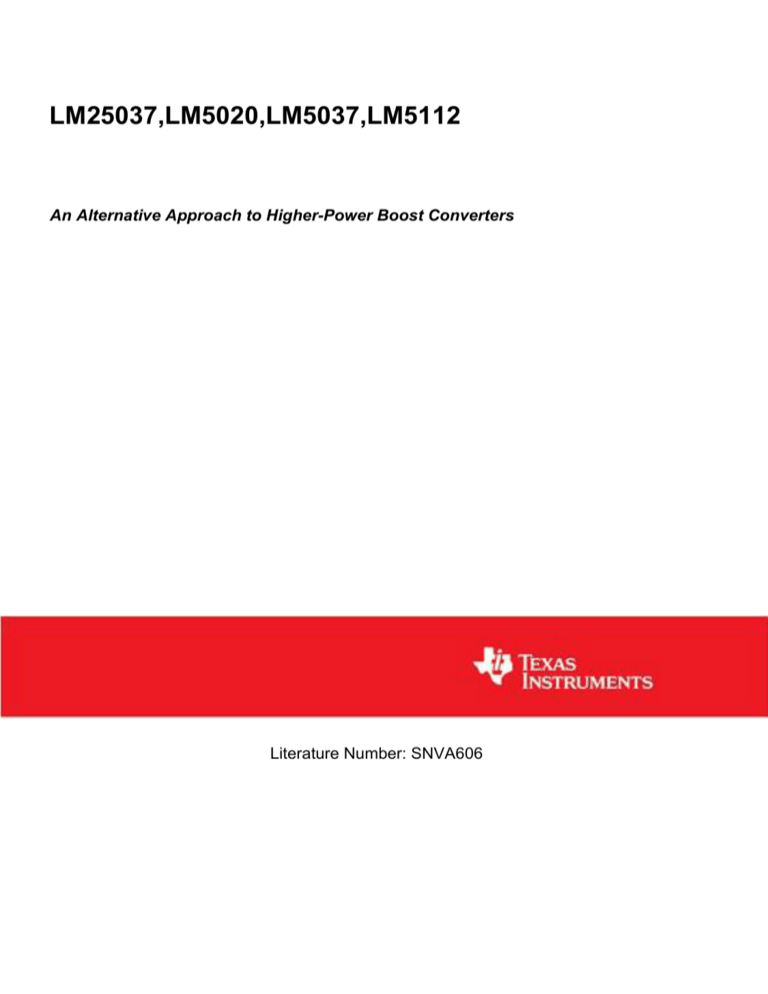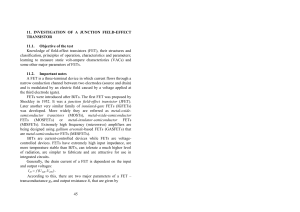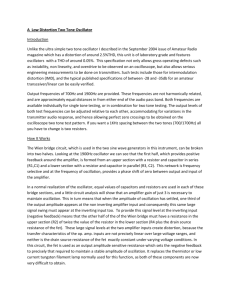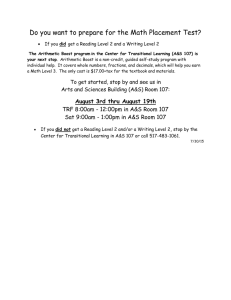
LM25037,LM5020,LM5037,LM5112
An Alternative Approach to Higher-Power Boost Converters
Literature Number: SNVA606
POWER designer
Expert tips, tricks, and techniques for powerful designs
www.national.com/powerdesigner
No. 127
An Alternative Approach to Higher-Power
Boost Converters
— By David Baba, Product Applications Engineer
A higher-power boost converter often requires special
consideration to minimize power losses and temperature rise in the FETs, diode, and inductor. Regarding
FETs, many designers opt to place FETs in parallel to
reduce conduction losses. However, placing FETs in
parallel can increase transitional losses. This article
discusses a number of approaches that can be considered
to reduce total losses in boost FETs. Possible options
include selecting lower gate-charge FETs, selecting
alternative controllers with higher gate-drive current, or
using a gate driver such as the LM5112. An alternative
approach using National Semiconductor’s PowerWise®
LM25037 dual-output gate-drive controller and its
benefits are considered as compared to using a single
gate-drive controller such as the LM5020. Further, this
article will examine ways to approximate total FET
losses and then make a selection from the potential
approaches that best suits the application requirement.
General Overview of a Boost Converter
Figure 1 shows: a boost converter with its basic
components, (a); the operation of the boost converter
during the on period D, (b); and the operation during
the off period (1-D), (c).
All three waveforms in Figure 2 illustrate behavior
over one complete switching cycle. In (a), the inductor
current can be seen; in (b), the switch current is
depicted; and in (c), the voltage across the FET is
illustrated.
The boost converter supplies a voltage that is always
greater than its source voltage. The volt-second balance
of the inductor L, for the D period, is added to the input
voltage during the (1-D) period and is rectified to the
L
(a)
VIN
ID
+
t
-
DTS
L
TS
IDS
Q +
VDS
-
VIN
C
-
- VL (t)
VIN
R
VOUT
R
VOUT
R
VOUT
IC (t)
+
L
(c)
C
IL (t)
+ VL (t) -
(b)
D
IL (t)
+
IC (t)
+
C
-
Figure 1. The Boost Converter during
the D and (1-D) Switching Period
VOUT
TS
VIN
IL
ISW (PK)
IAVE
(a)
DTS
(1-D) TS
t
ISW (PK)
ISW (PK)
IAVE
(b)
DTS
(1-D) TS
t
VDS
VOUT =
(c)
DTS
VIN
(1-D)
(1-D) TS
Figure 2. Basic Behavioral Waveforms of the Boost Converter
POWER designer
An Alternative Approach to Higher-Power Boost Converters
output through the diode. The longer the D period,
the shorter the 1-D period becomes, thereby
increasing the voltage during the off time in order
to maintain volt-second balance.
A benefit to the alternative approach using the
LM25037 PWM controller is evident in applications
where the output voltage is many times greater than
the input. The relationship of input and output
voltage as it relates to the duty ratio is highlighted in
the following equation:
EQ1
VOUT
VIN
1
( 1 − D)
From Equation 1, it is apparent that a singlechannel gate-drive solution with a limited maximum
duty ratio can inhibit large step-up ratios. Some
controllers have a maximum period of 80% which
will limit the step-up ratio to five times the input.
However, using the LM25037 controller presents
no such limitations. The reason for this is that the
alternating outputs of the LM25037 gate driver
have only a small dead time between the two
outputs which allows a maximum duty ratio beyond
80%. And therefore, it is possible to obtain output
voltages that are 10 times the input.
Losses in the Boost FET
Losses due to the boost FET can be separated into
three different categories, namely, conduction,
transition, and switching losses. Conduction and
transition losses are discussed as they are dissipated
directly in the FET which impacts thermal
performance.
Conduction Losses
Conduction losses in the boost FET are directly
related to the output power of the boost converter,
the input voltage, the output voltage (relating to D),
and the RDSON of the FET.
2
Conduction loss is an I2R term where I is the RMS
switch current and R is the RDSON of the FET. For
a boost converter, the conduction losses are shown
in the following equations.
SW COND = I SWRMS2 x RDSON
EQ2
Where
EQ3 I SW
RMS
=
Dx I 2+I
( PEAK PEAK x I TROUGH + I TROUGH2)
3
EQ4
IPEAK = 1.25 x IINAVE
EQ5
I TROUGH = 0.75 x IINAVE
EQ6
IINAVE =
EQ7
D=
I OUT
(1-D)
V OUT - V IN
V OUT
Note: Equations 3 and 4 relate to the peak-to-peak
inductor current which is 50% of the average input
current.
POWER designer
Transitional Losses
Transitional losses occur during the time period
when the FET is turning on or off. During steadystate operation before the FET turns on, the output
voltage is across the drain and the source of the
FET. As the FET begins to turn on, current begins
flowing from the drain to the source after which the
voltage begins to fall. During this time, the current
is increasing as the voltage remains across the FET
and losses are incurred. During turn off, the exact
reverse occurs.
As the frequency increases, transitional losses
increase as more transitions occur per second.
Also, if transition times increase, transitional losses
increase because the FET endures a longer period of
time within the described loss period. Transitional
losses can be approximated by the following
equations:
EQ8
TransLOSSES = 2 x VOUT x IINAVE x TTRANS x FSW
Where
EQ9
VOUT =
EQ10
IINAVE =
V IN
(1 - D)
I OUT
(1 - D)
FSW is the switching frequency and TTRANS is the
transitional switching time.
Figure 3 depicts a graph showing the drain current
and the voltage across the FET and illustrates how
much charge is required to fully turn on the FET.
www.national.com/powerdesigner
Volts/
Current
ID
VDS
VGS
Plateau
Voltage
VGS (TH)
Charge (nC)
Miller Charge (Q)
Figure 3. Approximating Transitional Switching Time
The charge relates to time and is proportional to the
gate-drive current being supplied to the gate of the
FET. The more available current, the quicker the
FET will turn on. Conversely, turning off the FET
requires that the gate driver sinks current out of
the gate, and thus, the more current the gate driver
can sink, and the faster the FET will turn off. For
the purpose of simplicity, it is assumed the turnon time is equal to the turn-off time, with the gate
driver providing the same source and sink-current
capability.
Many FET datasheets include a graph that relates
the VGS on the Y axis with the charge on the X axis.
Figure 3 has additional VDS and ID curves for relating
the topic being discussed. To estimate the charge
required to fully switch on a FET, the designer must
estimate the differential charge, shown as the Miller
charge. Another approximation can be made by
estimating the Miller charge to be approximately
60% of the typical gate charge.
The gate drive resistance for MOSFET gate drivers
is typically quoted in its datasheet. For the Bipolar
Junction Transistor (BJT) output stage, it will not
be quoted as a resistance. VSAT is quoted for a BJT
3
POWER designer
An Alternative Approach to Higher-Power Boost Converters
output-driver stage. However, the VSAT information
provided can be used to approximate the drive
resistance as is seen in the following equation. The
VG DROP is the VSAT of the transistor output stage.
EQ11
By way of example, a boost specification will be
considered using the two-switch approach and
compared to the single gate-drive, parallel-switch
approach.
VIN = 12V
VG DROP
= Dr iveR
GateCURRENT
VOUT = 24V
IOUT = 6A
The voltage available to drive a FET needs to be
determined. This is simply calculated by subtracting
the Miller plateau voltage from the total output
voltage at the gate drive. The voltage available to
drive the FET after its threshold is met is:
EQ12
VG AVAIL = VGATE - VGS (MP)
Equation 11 calculates the resistance of the gate
driver. From this calculation, the gate-drive current
is therefore:
EQ13
IGATE =
VG AVAIL
Dr iveR + RG
where, RG is the gate resistance of the FET.
Once the gate-drive current is determined, the
transitional time can be calculated:
EQ14
TTRANS =
Charge Miller
IGATE
Fsw = 300 kHz
L = 3.6 μH
Single Gate-Drive Parallel-FET Approach using
the LM5020 Controller
Considering the previously-identified specification,
the designer may opt to use National’s LM5020
PWM controller. The LM5020 controller is a
common selection for many boost applications
and serves as a good comparison in a typical design
scenario.
Placing two FETs in parallel will increase switching
losses as the gate charge will double and therefore
switching transition times will double. With high
RMS switch currents and the doubling of gate
charge, it is essential to select FETs that have a low
RDSON and a low gate charge. These types of FETs
tend to be more costly than FETs that have similar
RDSON with a higher gate charge. To address this
transitional loss issue, the FET selected for this
example is the SiR472DP FET from Vishay.
D
VIN
LM 5020
And the evaluation of transition losses (Equation 8)
is now possible.
OUT 1
Q1
Q2
C
Figure 4. A Single Gate-Drive Controller Switching
Two FETs in Parallel
4
R
POWER designer
A traditional method of using a single gate-drive
controller switching two FETs in parallel is shown
in Figure 4.
From the calculation in Equation 7,
D = 0.5
and from Equation 6, the average input current is
calculated as:
IINAVE = 12A
Choosing 50% of the average input current as being
the peak-to-peak current in the inductor and using
Equations 4 and 5, this yields the following peak
and trough values:
IPEAK = 15A
datasheet. By referencing the SiR472DP datasheet
and using the VGS verses total gate charge (nC) in
a graph similar to the one shown in Figure 3, the
Miller charge is shown to be 4 nC for a VDS of 24V.
The effective Miller charge doubles (8 nC) due to
two FETs being placed in parallel.
The LM5020 datasheet does not provide gatedrive resistance data as it has a BJT output stage,
but the source resistance of the gate drive can still
be estimated. The table on page 5 of the LM5020
datasheet shows the voltage drop (0.25V) of the
gate-drive output for a given sourcing current
(0.05A). By dividing the current flowing out of the
gate drive into the voltage drop, the gate resistance
can be estimated. Using Equation 11 yields:
Dr iveR = 5Ω
The LM5020 controller has an output gate-drive
voltage of 7.6V supplied by the VCC regulator; from
Equation 12:
ITROUGH = 9A
VG AVAIL = 4.6V
Using Equation 3, the switch RMS currents can be
calculated:
A gate resistance of 1.8Ω (typical) is specified in
the SiR472DP datasheet. Using Equation 13, the
gate-drive current can be calculated:
ISWITCHRMS = 8.57A
IGATE = 0.68A
And the conduction losses also can now be calculated. The RDSON for the SiR472DP is 0.012Ω at
10V of gate-drive voltage. As two of these FETs are
placed in parallel, the effective RDSON, is half of this
value (0.006Ω).
SWCOND = 0.441W
In order to evaluate Equation 8, the transitional
switching time must be estimated. It is assumed the
VGS(th) of the SiR472DP is 1.85V (typical) from the
www.national.com/powerdesigner
Using Equation 14, the transitional time yields:
TTRANS = 11.76 ns
Using Equation 8, the transitional losses can be
approximated to:
TransLOSSES = 2W
5
POWER designer
An Alternative Approach to Higher-Power Boost Converters
By adding the conduction losses with transitional
losses, the total FET losses are obtained. Total
FET losses using the single gate-drive parallel-FET
method is:
FETLOSS TOTAL = 2.47W
Half of the calculated power (1.24W) is dissipated
in each FET.
There are alternative approaches in circumstances
where the single gate-drive approach is causing the
FET to dissipate too much power. For example, a
single gate-drive controller with higher drive current
(if one is available) can be employed or an additional
IC using the gate driver (LM5112) can be used.
Another alternative is to consider the dual gatedriver approach.
Dual-Output Gate-Driver Approach using the
LM25037 Controller
A basic schematic of the LM25037 dual gate driver
switching the gates of two FETs independently is
shown in Figure 5.
D
VIN
LM 25037
Q1
OUT 1
Q2
C
R
RDSON. Switching FETs independently, however,
no longer yields the 50% reduction in RDSON but
transitional losses are reduced.
The RDSON of the SiR468DP is 0.0057Ω. The
duty ratio (D) for each FET is now reduced to 25%
due to the independent switching of the FETs.
Using Equation 2 and using the revised effective D,
we yield:
ISWITCHRMS = 6.06A
SWCOND = 0.209W
There are two FETs dissipating the above conduction
losses. The total conduction losses are twice this
amount, therefore the total conduction losses in
both FETs are:
SWCOND TOTAL = 0.42W
Each gate drive of the LM25037 controller has the
same gate-current drive capability as the LM5020
controller. The datasheet specifications can be
referred to for more details.
A gate resistance of 1.1Ω (typical) is specified in
the SiR468DP datasheet. Using Equation 13, the
gate-drive current can be calculated as:
OUT 2
IGATE = 0.75A
Figure 5. LM25037 Dual-Output Gate Drivers
Switching Two FETs Independently
Switching two independent FETs from a dual gatedrive controller typically allows the designer to
select low RDSON FETs with a higher gate charge.
Higher gate-charge FETs tend to be less expensive
than their lower gate-charge counterparts.
The two FETs selected to be switched independently
are the SiR468DP. As previously mentioned, driving
two FETs in parallel produces a 50% reduction in
6
It is assumed the VGS(th) of the SiR468DP is 2V
(typical) from the datasheet. From the SiR468DP
datasheet, using the VGS versus total gate charge
similar to the graph shown in Figure 3, the Miller
charge is shown to be 6 nC for a VDS of 22.5V. Using
a dual gate-drive controller switching independent
FETs reduces the transitional losses due to the
halving of the effective Miller charge which decreases
the transitional switching times. Transitional
switching time is calculated using Equation 14:
TTRANS = 7.96 ns
POWER designer
R14
TDK C3216X5RIC106
TDK C3216X5RIC106
C3
VIN 11V to 14V
L1
3.6 μH
Coilcraft, SER2013-362ML
C4
C19
NI D1 NI
TDK, C3216X7RIE475
TDK, C3216X7RIE475 TDK, C3216X7RIE475
TDK, C3216X7RIE475
L2
C1
IR, 42CTQ030S
Pulse, PA1005.100NL
2
11 L3
GND GND
GND
GND
C6
GND
C8
GND
330 nH
Coilcraft,
DO1813-331
+
C7 + C9
24V @ 6A
GND GND
R1
4 10k
12
GND
GND
C2
Sanyo, 35SVPD47M
Sanyo, 35SVPD47M
GND
R2
10R
Q1
Vishay,
SI7892BDP
R3
75k
C10
GND
U1
1 μF
VIN
GND
0.047 μF
C20
GND
C15
4.7 μF
GND
R10 R11
19.6k 20k
C16
0.01 μF
GND GND
GND
OUTA
REF
OUTB
RT1
RAMP
RT2
CS
RES
COMP
SS
GND
VCC
UVLO
C17
0.047 μF GND
AGND
R6
5.9k
Q2
Vishay,
SI7892BDP
LM25037AMT
PGND
R5
45.3k
GND
GND
GND
C11
1k
FB
C18
4.7 μF
R9
C13
1k
100 nH
R12
1.5R
C14
820 pF
GND
1000 pF
C12
D4
BAT54
R7
470 pF
GND
GND
R8
18.2k
R13
1k
GND
Figure 6. Application Example of a 12V IN, 24V OUT at 6A
From Equation 8:
TransLOSSES = 1.37W
Including the conduction losses, the total losses in
both FETs are:
FETLOSS TOTAL = 1.79W
The total FET losses recovered using two
independent gate drives are:
FETLOSS REC = 2.47W - 1.79W = 0.675W
Each FET will dissipate 0.34W less.
Summary
Using the LM25037 controller for higher-power
boost applications is a simple straightforward
approach that can provide benefits over using a
typical single gate-drive controller. The benefits can
include higher step-up ratios and lower FET losses
due to the reduction in transitional losses. Although
there are a number of possible approaches to reduce
total FET losses in higher-power boost converters,
the equations in this article can be used to calculate
total losses in the boost FETs for a number of
different approaches. Considering the 150W boost
converter example, it has been shown that total
losses in the FETs are reduced when comparing the
LM25037 dual-output gate-drive controller with
the LM5020 single-output gate-drive controller.
Figure 6 shows an example schematic of the boost
example considered.
www.national.com/powerdesigner
7
Power Design Tools
Design, build, and test analog circuits in this online
design and prototyping environment.
www.national.com/webench
Expand your knowledge and understanding of
analog with our free online educational training
tool.
www.national.com/training
National’s monthly analog design technical
journal.
www.national.com/edge
Tools for Energy-Efficient Designs
Access white papers, reference designs, and application notes on
PowerWise® products and systems.
www.national.com/powerwise
National Semiconductor
2900 Semiconductor Drive
Santa Clara, CA 95051
1 800 272 9959
Mailing address:
PO Box 58090
Santa Clara, CA 95052
Visit our website at:
www.national.com
For more information,
send email to:
support@nsc.com
Don’t miss a single issue!
Subscribe now to receive email alerts when
new issues of Power Designer are available:
www.national.com/powerdesigner
Read our Signal Path Designer® online
today at:
www.national.com/spdesigner
©2009, National Semiconductor Corporation. National Semiconductor, , PowerWise, WEBENCH, and Signal Path Designer are registered trademarks of
National Semiconductor. All other brand or product names are trademarks or registered trademarks of their respective holders. All rights reserved.
550263-019
550263-019
IMPORTANT NOTICE
Texas Instruments Incorporated and its subsidiaries (TI) reserve the right to make corrections, modifications, enhancements, improvements,
and other changes to its products and services at any time and to discontinue any product or service without notice. Customers should
obtain the latest relevant information before placing orders and should verify that such information is current and complete. All products are
sold subject to TI’s terms and conditions of sale supplied at the time of order acknowledgment.
TI warrants performance of its hardware products to the specifications applicable at the time of sale in accordance with TI’s standard
warranty. Testing and other quality control techniques are used to the extent TI deems necessary to support this warranty. Except where
mandated by government requirements, testing of all parameters of each product is not necessarily performed.
TI assumes no liability for applications assistance or customer product design. Customers are responsible for their products and
applications using TI components. To minimize the risks associated with customer products and applications, customers should provide
adequate design and operating safeguards.
TI does not warrant or represent that any license, either express or implied, is granted under any TI patent right, copyright, mask work right,
or other TI intellectual property right relating to any combination, machine, or process in which TI products or services are used. Information
published by TI regarding third-party products or services does not constitute a license from TI to use such products or services or a
warranty or endorsement thereof. Use of such information may require a license from a third party under the patents or other intellectual
property of the third party, or a license from TI under the patents or other intellectual property of TI.
Reproduction of TI information in TI data books or data sheets is permissible only if reproduction is without alteration and is accompanied
by all associated warranties, conditions, limitations, and notices. Reproduction of this information with alteration is an unfair and deceptive
business practice. TI is not responsible or liable for such altered documentation. Information of third parties may be subject to additional
restrictions.
Resale of TI products or services with statements different from or beyond the parameters stated by TI for that product or service voids all
express and any implied warranties for the associated TI product or service and is an unfair and deceptive business practice. TI is not
responsible or liable for any such statements.
TI products are not authorized for use in safety-critical applications (such as life support) where a failure of the TI product would reasonably
be expected to cause severe personal injury or death, unless officers of the parties have executed an agreement specifically governing
such use. Buyers represent that they have all necessary expertise in the safety and regulatory ramifications of their applications, and
acknowledge and agree that they are solely responsible for all legal, regulatory and safety-related requirements concerning their products
and any use of TI products in such safety-critical applications, notwithstanding any applications-related information or support that may be
provided by TI. Further, Buyers must fully indemnify TI and its representatives against any damages arising out of the use of TI products in
such safety-critical applications.
TI products are neither designed nor intended for use in military/aerospace applications or environments unless the TI products are
specifically designated by TI as military-grade or "enhanced plastic." Only products designated by TI as military-grade meet military
specifications. Buyers acknowledge and agree that any such use of TI products which TI has not designated as military-grade is solely at
the Buyer's risk, and that they are solely responsible for compliance with all legal and regulatory requirements in connection with such use.
TI products are neither designed nor intended for use in automotive applications or environments unless the specific TI products are
designated by TI as compliant with ISO/TS 16949 requirements. Buyers acknowledge and agree that, if they use any non-designated
products in automotive applications, TI will not be responsible for any failure to meet such requirements.
Following are URLs where you can obtain information on other Texas Instruments products and application solutions:
Products
Applications
Audio
www.ti.com/audio
Communications and Telecom www.ti.com/communications
Amplifiers
amplifier.ti.com
Computers and Peripherals
www.ti.com/computers
Data Converters
dataconverter.ti.com
Consumer Electronics
www.ti.com/consumer-apps
DLP® Products
www.dlp.com
Energy and Lighting
www.ti.com/energy
DSP
dsp.ti.com
Industrial
www.ti.com/industrial
Clocks and Timers
www.ti.com/clocks
Medical
www.ti.com/medical
Interface
interface.ti.com
Security
www.ti.com/security
Logic
logic.ti.com
Space, Avionics and Defense
www.ti.com/space-avionics-defense
Power Mgmt
power.ti.com
Transportation and Automotive www.ti.com/automotive
Microcontrollers
microcontroller.ti.com
Video and Imaging
RFID
www.ti-rfid.com
OMAP Mobile Processors
www.ti.com/omap
Wireless Connectivity
www.ti.com/wirelessconnectivity
TI E2E Community Home Page
www.ti.com/video
e2e.ti.com
Mailing Address: Texas Instruments, Post Office Box 655303, Dallas, Texas 75265
Copyright © 2011, Texas Instruments Incorporated







